Boeing has introduced its newest unmanned platform, the Boeing Airpower Teaming System.
Designed by Boeing Australia, it is the company’s largest investment in a new unmanned aircraft program outside the United States.
The company say that the aircraft will complement and extend airborne missions through smart teaming with existing military aircraft.
“The Boeing Airpower Teaming System will provide a disruptive advantage for allied forces’ manned/unmanned missions,” said Kristin Robertson, vice president and general manager of Boeing Autonomous Systems.
“With its ability to reconfigure quickly and perform different types of missions in tandem with other aircraft, our newest addition to Boeing’s portfolio will truly be a force multiplier as it protects and projects air power.”
The Boeing Airpower Teaming System will:
— Provide fighter-like performance, measuring 11.7 metres and able to fly more than 2,000 nautical miles;
— Integrate sensor packages onboard to support intelligence, surveillance and reconnaissance missions and electronic warfare;
— Use artificial intelligence to fly independently or in support of manned aircraft while maintaining safe distance between other aircraft.
“This aircraft is a historic endeavor for Boeing. Not only is it developed outside the United States, it is also designed so that our global customers can integrate local content to meet their country-specific requirements,” said Marc Allen, president, Boeing International.
“The Boeing Airpower Teaming System provides a transformational capability in terms of defense, and our customers – led by Australia – effectively become partners on the program with the ability to grow their own sovereign capabilities to support it, including a high-tech workforce.”
First flight is planned for 2020.




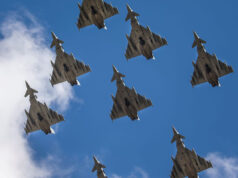

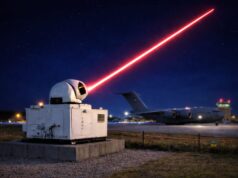

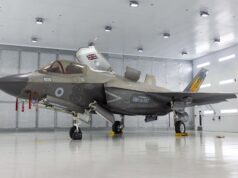
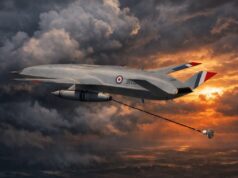
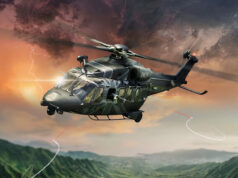



This must be the future, no G-forces to worry about, nor pilot fatigue, or horrendously expensive training programmes. The $64,000 question must be; what can’t this plane do, that only a manned craft can? There must be an opportunity to purchase more airframes in the future, that benefits from excluding pilot overheads. Ground staff numbers could drop a little too, and the prospect of casualties falling must be an incentive?
There’s quite a few programs heading in this direction:
Aero India 2019: HAL unveils Unmanned Wingman concept
“India’s Hindustan Aeronautics Limited (HAL) unveiled its Unmanned Wingman concept at the Aero India 2019 exhibition held in Bangalore from 20–24 February. The Unmanned Wingman concept is currently envisioned to be a 6 m-class, low-observable, multipurpose unmanned combat air vehicle (UCAV) with an endurance of up to 80 minutes and a range of 800 km, although its size can be scaled up for greater endurance or payload capacity should there be a customer requirement. The development is an effort led by HAL with industry partners, including a local start-up called NewSpace Research and Technologies (NRT), to develop low-cost platforms that can provide on-call support to forward-deployed combat aircraft operating in contested airspace. The proposed UCAV design depicts an aerodynamic almond-shaped nose, mid-wing monoplane with slender fuselage and V-tail. According to HAL specifications, the air vehicle will have a maximum take-off weight (MTOW) of 1,300 kg and will be 6.4 m long and 4.4 m wide.”
Wingman of the future: U.S Air Force successfully tests fully autonomous F-16 drone
The U.S. Air Force has successfully converted an F-16 fighter jet into an autonomous combat drone capable of flying missions independently as well as a part of larger operations supported by manned aircraft. This latest development in the program known as “Have Raider II” could potentially turn aging fighter jets into semi-disposable wingmen for more advanced, piloted planes like the F-22 and F-35 Joint Strike Fighter. It also could dramatically increase the combat capabilities of the U.S. drone arsenal, as the aging F-16 could still put many military drone craft to shame in terms of flight and operational capabilities. Attempts at “dronifying” the F-16 were validated by two weeks of exercises conducted at Edwards Air Force Base in California recently. Staff from the Air Force Research Lab, the U.S. Air Force Test Pilot School, Lockheed Martin, and Calspan Corporation were all involved in the project and conducting of exercises that included having the F-16 plan and execute air strikes according to “mission priorities and available assets.”
The Air Force Valkyrie Drone, a Sidekick for Human-Piloted Planes, Will Fly This Year
Later this year, the U.S. Air Force will test a new concept drone designed to act like a sidekick to combat planes with human pilots. The service sees the XQ-58A “Valkyrie,” or something very much like it, as a cost-effective way to augment the service’s current aircraft fleet. Kratos, a builder of target drones, has been developing the XQ-58A. Under the Air Force’s “loyal wingman” concept, a drone wingman could act in concert with its crewed partner to shoot down enemy fighters, run interference for the crewed airplane as it carries out an attack, or suppress and destroy enemy air defenses before the crewed plane enters range. The Air Force Research lab launched the XQ-58A out of the larger Low-Cost Attritable Strike Demonstrator (LCASD) program, which was envisioned as a way of adding more airframes, firepower, and capability to the Air Force without building crazy-expensive new fighter jets. After all, not every mission needs a fully functional aircraft with pilot onboard. In 2016, when the Air Force awarded the LCASD contract to Kratos, Popular Mechanics reported: “The drone will be capable of Mach 0.9 speeds for short periods of time, have a 1,500-nautical-mile range, and be able to carry at least two GBU-39 small diameter bombs. It will feature ‘extreme agility’ for missile avoidance.”
Japan Wants Combat Drones That Can Fly in Formation With Its Fighters
The Japanese Ministry of Defense has released new details about its plans for future unmanned aircraft that would fly in supporting roles, aiding piloted fighters in the Japanese Air Self-Defense Force, or JASDF. Specifically, JASDF is hoping to add two distinct craft to its fleet: unmanned wingmen that would fly in formation with and receive commands from a pilot in a conventional fighter, and a high-flying ballistic-missile defense (BMD) aircraft that would use sensor arrays to track missile threats.
Not heard of anything similar from the Uk.
“Not heard of anything similar from the Uk” – you have but probably not in the way you expected.
The optionally manned capability planned for Team Tempest will have to provide the most sophisticated control both in warfare and in peacetime in order to operate unmanned in commercial/non-segregated airspace at potentially > Mach 1 speeds. This system will then be capable of supporting smaller less complex unmanned wingman and independent action unmanned aircraft. Building airframes isn’t the hard part, its developing the software and system reliability and fail-safes to achieve the levels of trust required. If the aircraft is not certified for commercial/non-segregated airspace then it significantly constrains where it can fly/train in Europe in peacetime. Hence Protector and Watchkeeper certifications requirements.
F-35 illustrates the complexity and time required to develop software for 5th gen operations, while the current paucity of drones licensed/certified for flight in commercial airspace and Watchkeeper experience show the challenges.
I wonder what it would take to make a British F35B unmanned and fly from the Carriers. Anyway have we even got drones that can fly from the Carriers?, Drones are a great asset and it would be nice to be able to put a Drone in the air where and when we want to from our carriers for recon or strike missions, TARANIS would be amazing if it could operate from the carriers. I hope we will be able to launch and recover large Drones in future. And Drone techs only getting better, We should develop more drones in the UK for Eg a Sub Hunting Drone for the North/South Atlantic would be great and they could also monitor fishing and help with search and rescue, surely cheaper than huge warships or planes, and with our limited number of both warships and planes maybe drones would and could help out immensely in so many areas.
I’m sure a number of F35’s will be converted into drones, before it goes out of service. The same may happen to some Typhoons, and even attack helicopters, where reducing human losses could be too attractive to ignore? The prospect of unmanned combat aircraft replacing the current fast jet fleets is extremely high.
I think we will end up with different tiers of drones personally. Ships and certain army applications will want small, missile like drones that can hunt in packs and be expendable. Medium sized drones such as the Boeing and Kratos offerings will be used initially for wingman buddy’s that can distract and confuse whilst the manned fighters slip in and do their stuff, and then a high end drone such as Taranis will end up being used for surveillance and covert deep strike.
I do believe that by the time we actually build Tempest, it may be already irrelevant. Drones operating by themselves have the capability to out do anything that has a man in the loop. All hooked in to a super fast hive mind that is programmed to be able to identify and prioritise targets and assess the best options for attacking, then reevaluate in the blink of an eye if one drone is say destroyed, would be relentless and indefensible.
Also the savings could be massive. At the moment, every manned fighter has to have the complete package, radar, ew, missiles etc making them prohibitively expensive. Also, they have to be over engineered to safely operate for thousands of hours due to training requirements. A swarm of drones will be able to have some with radar, some carrying weapons, some carrying out electronic attacks with all info gathered being shared across all the drones by the hive mind. This reduces the cost by not needing every bit of equipment on every drone. They could also be engineered to a much lower standard as the airframes will get minimal use due to no training requirements, only occasional certification tests.
Then there is the performance factor, unmanned will be able to pull eyewatering turns that will make both hunting traditional manned platforms easy and be more comparable to the missiles that will be fired at them.
I think we are a long way from an unmanned and AI controlled drone becomes politically acceptable. One mistake and it will be the end of them.
We are seeing the same with self driving cars, one or two incidents and the whole research has now been put back probably another decade or more before they can realistically start becoming main stream.
In reality practical self driving cars were always a decade away from the hype those with an interest to promote them wanted us to believe. Technically being able to do something and doing it in a totally acceptable, reliable and successful way is quite different. I think you are correct in your assessment here of drone tech its that last 5% that is the most difficult to solve and inevitably included in that are aspects well beyond the actual technology.
Tempest should be canceled. We can operate hundreds of not thousands of drones for the same price. F35 keeps us in the manned fighter business almost until the 22nd Centuary. A manned F35E with adaptive engine should be the last manned fighter the RAF ever flys. No need for another multi billion pound fighter program.
Looking at this sort of technology makes you wonder about the relevance of the Tempest program. While it remains to be seen whether anything comes from this it seems that even Australia (not to be too dismissive) can afford to develop sixth gen technology. I wouldn’t be surprised if we don’t see a large number of similar programs follow suit.
A relatively simple airframe matched up with the sort of computer processing capability you are likely to find in your average iPhone and you can very quickly build yourself quite a deadly little attack drone. The development time for this aircraft is only set out for four years which could see them entering service en masse from the mid 20s.
A world full of armed autonomous drones is just a little bit scary.